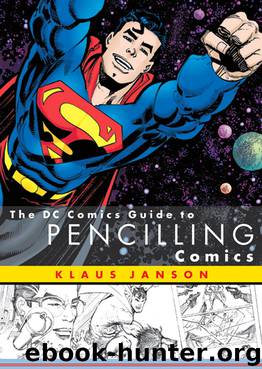The DC Comics Guide to Pencilling Comics by Klaus Janson

Author:Klaus Janson [Janson, Klaus]
Language: eng
Format: epub
ISBN: 978-0-7704-3456-4
Publisher: Crown Publishing Group
Published: 2013-04-10T04:00:00+00:00
The next time we see him, in panel 4, he is in a deliberately chosen composition. The shape of the desk seems to squeeze the sleazy guy compositionally the same way that he is being “squeezed” by Mr. Whisper. It’s a visual representation of the action that is occurring. I introduced the silhouette of the lamp to represent the feeling that the sleazy guy is being watched. I stuck to that theme in the last panel, too, where the windows were meant to represent eyes looking in, watching the character. The last panel also pulls back farther than it ever has in that office. The idea was to generate the feeling of isolation and loneliness that the sleazy guy is feeling.
If you look closely at the angles of the panels, you will see only one angled panel in the entire sequence: panel 5 on the second page. Even though the first and last panels have distortion in their perspective, their axis is vertical. The axis in panel 5 is definitely at a diagonal. This separated it from the rest of the panels and hopefully made it stand out more.
In retrospect, I’d like to change the establishing shot in the first panel on the first page. The distortion of the buildings doesn’t work for me. I remember sensing something was off even when I drew it, but didn’t listen to myself.
There was also a drawing problem that was left unsolved. If I remember correctly, the script called for the guy in the phone booth to be wearing a wig. Now that I’ve called attention to it, you might see that there was at least an attempt made, but no success. It’s an interesting problem to deal with. How does an artist distinguish between a bad hairpiece and a bad haircut? Next time I swear I’ll get it!
By showing you choices I have made, I don’t mean to restrict you in any way; quite the opposite! Hopefully, some doors have been opened. These panels and pages are meant to illustrate in a simple way the range of possibilities for visual storytelling. When I sit down to draw, I know my first priority is clarity. I will do whatever I can to visually emphasize story or character points. My second priority is to make the story interesting, and I will make choices to do that, too. Storytelling is limited only by the imagination of the individual artist. Comics can go anywhere, in any direction. How fun is that?!
The storyteller needs to read the scene more than once to make sure no information is missed. Ask yourself these questions: Who’s involved? What’s going on? What time of day is it? Where does the scene take place? Once you have answered these questions clearly, you can begin to pass the information on to the reader.
Some artists may be concerned that the rules or theories of storytelling might hinder their self-expression. Nothing could be further from the truth. Anyone can sit down with a pencil and paper and say that they are drawing.
Download
This site does not store any files on its server. We only index and link to content provided by other sites. Please contact the content providers to delete copyright contents if any and email us, we'll remove relevant links or contents immediately.
Adulting by Kelly Williams Brown(4487)
Drawing Cutting Edge Anatomy by Christopher Hart(3454)
Figure Drawing for Artists by Steve Huston(3381)
Draw Your Day by Samantha Dion Baker(3288)
Drawing Shortcuts: Developing Quick Drawing Skills Using Today's Technology by Leggitt Jim(2996)
Make Comics Like the Pros by Greg Pak(2852)
Rapid Viz: A New Method for the Rapid Visualization of Ideas by Kurt Hanks & Larry Belliston(2834)
0041152001443424520 .pdf by Unknown(2784)
How Proust Can Change Your Life by Alain De Botton(2742)
Draw to Win: A Crash Course on How to Lead, Sell, and Innovate With Your Visual Mind by Dan Roam(2734)
How The Mind Works by Steven Pinker(2729)
Day by Elie Wiesel(2719)
Draw-A-Saurus by James Silvani(2655)
Tattoo Art by Doralba Picerno(2600)
Modern Cartooning by Christopher Hart(2557)
Learn Drawing Quickly by Sharon Finmark(2520)
Poses for Artists Volume 2 - Standing Poses: An essential reference for figure drawing and the human form. (Inspiring Art and Artists) by Justin Martin(2518)
Drawing and Painting Birds by Tim Wootton(2438)
Poses for Artists - Dynamic & Sitting: An essential reference for figure drawing and the human form (Inspiring Art and Artists Book 1) by Justin R Martin(2434)
